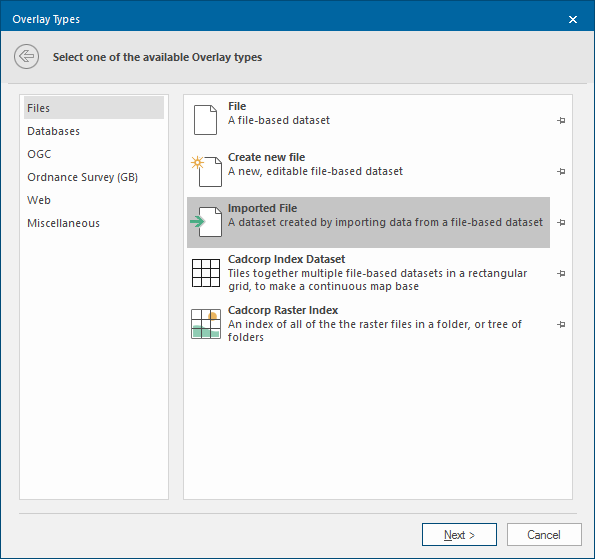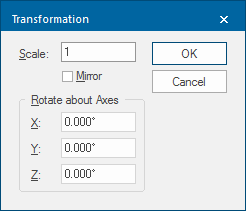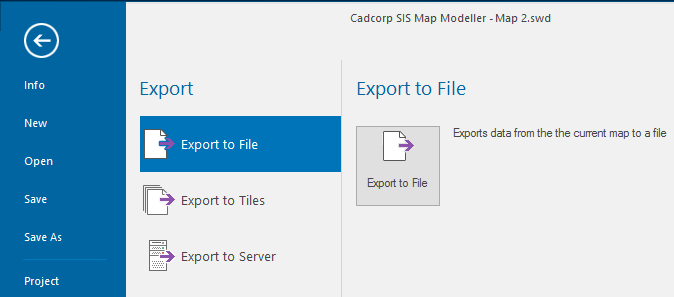DXF data
DXF (Data Exchange Format) is a widely used standard for transferring graphical data between computer-aided design and drafting (CAD) systems such as AutoCAD. Many architects and surveyors use CAD for the production of building plans, site layouts and survey drawings. Ordnance Survey also supplies many of its products in DXF format.
Geo-referenced DXF files
DXF files may be included as overlays using the Create New Overlay wizard in the usual way. If the graphics in the DXF file have been positioned using the National Grid coordinate system, and the unit of measurement used is the metre, DXF data appears in the correct geographical position.
DXF files which are not geo-referenced
Architects and engineers who have produced the data without regard to its location in the world may have selected a convenient local position as the origin of the coordinate system for the data. In this case SIS Desktop 9 provides the ability to move it to its correct geographical position, rotating it as necessary, and defining the units of measurement used.
To display a DXF file which is not correctly geo-referenced, it is important that you know the geographical location of at least one point on the DXF graphics. For instance, if you were using the National Grid coordinate system projection, you must establish the National Grid reference of a point on the DXF graphics. You may need to consult the provider of the DXF file to obtain this information.
Example
The following example uses a DXF file which is to be positioned within the National Grid.
-
Display the Overlay Types dialog and select Imported File.

Click Next and navigate to the required DXF file to be imported.
Note: It is recommended that any other overlays here are removed (select them, then click the Delete button in the local menu), or make them invisible (select them, and click on the Invisible radio button under Status on the Overlays dialog). -
If the Overlays dialog has been opened click the OK button to return to the map window. Do not be surprised if you cannot see any graphics. Remember, the DXF file is not geo-referenced, therefore the origin of its coordinate system (0,0) has been placed at the origin of the current map projection. In the case of the National Grid, this is near the Isles of Scilly off the south west coast of Britain.
-
Make the DXF overlay current, then use the Zoom Overlay local command. This will shift your current view to display the full extent of the current graphics (the DXF file).
-
Select any item in the DXF dataset by clicking on it.
-
Choose Move Dataset [Edit-Geometry-Arrange-Dataset].
-
For the position to move from, click on a point on the DXF graphics whose coordinate position you know.
-
If you want to scale or rotate the dataset before placing it, press Enter to display the Transformation dialog:

Scale
Enlarge or reduce the items on the cursor by the specified value. This value is relative to its current size, and ignores any previous enlargement or reduction.
Mirror
Check the tickbox to create a mirror image of the graphics on the cursor, using the specified angle as the mirror plane. 0 degrees is horizontal, 45 degrees is bottom-left to top-right and 90 degrees is vertical.
Rotate about Axes
X/Y - Define three-dimensional rotation about the X/Y axes. These options are only useful in 3D modelling.
Z - Rotate the items on the cursor through the specified angle. Positive angles are anti-clockwise, negative angles are clockwise.
On completion click OK.
-
To place the selected point in its correct geographical location, type in its coordinates (in the position bar at the bottom of the SIS Desktop 9 window), or click on existing graphics which are at the correct location.
-
When the DXF dataset is in the correct location, you can save it as a file using:

Remember to make any other overlays invisible, otherwise you will export them with the DXF.
The details of this transformation are saved in the file, so that when you next load this SWD file (using Open [Application]) the DXF dataset will be in the correct location.